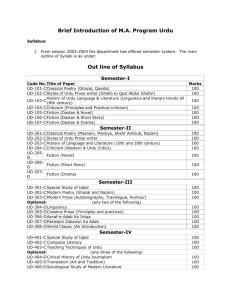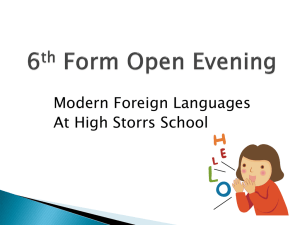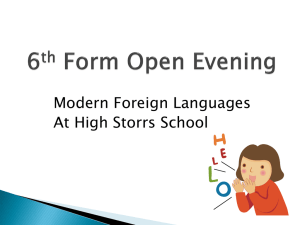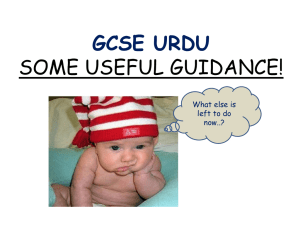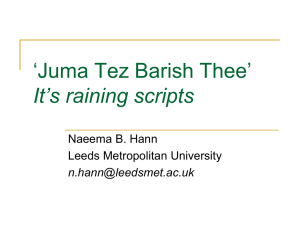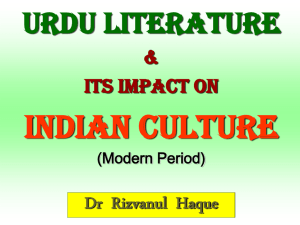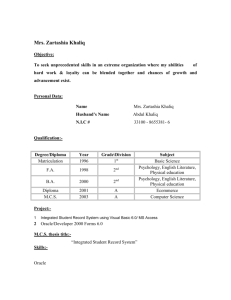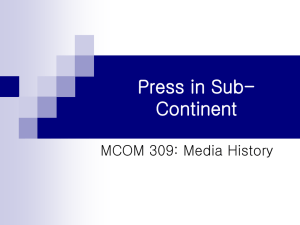10-Urdu and English (1)
advertisement
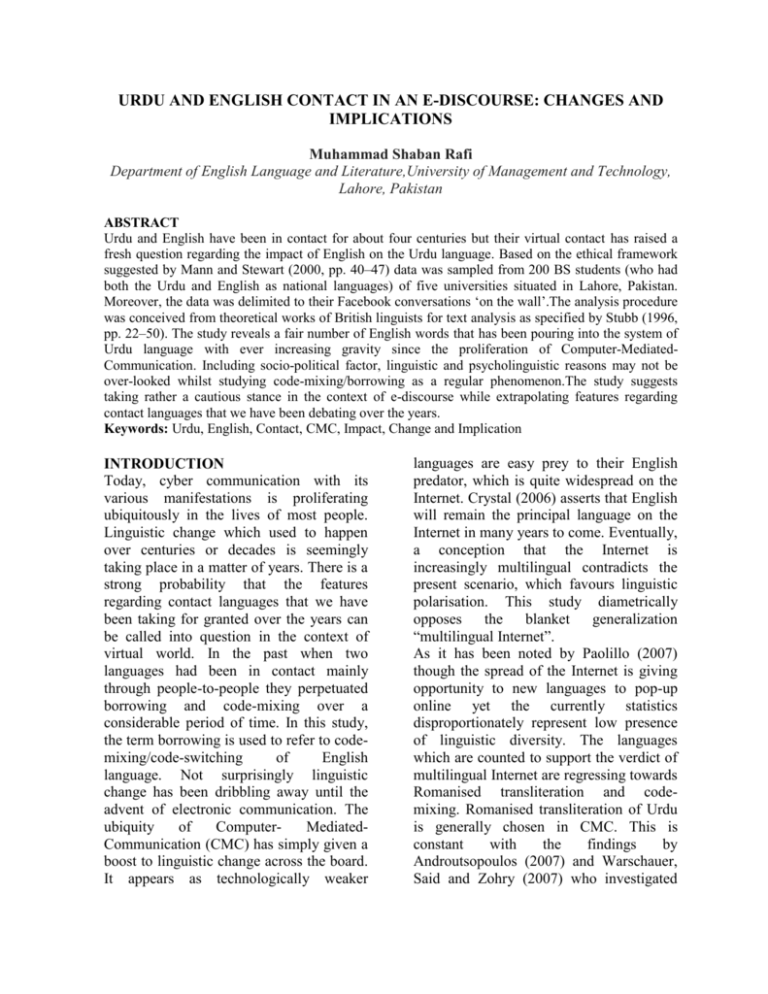
URDU AND ENGLISH CONTACT IN AN E-DISCOURSE: CHANGES AND IMPLICATIONS Muhammad Shaban Rafi Department of English Language and Literature,University of Management and Technology, Lahore, Pakistan ABSTRACT Urdu and English have been in contact for about four centuries but their virtual contact has raised a fresh question regarding the impact of English on the Urdu language. Based on the ethical framework suggested by Mann and Stewart (2000, pp. 40–47) data was sampled from 200 BS students (who had both the Urdu and English as national languages) of five universities situated in Lahore, Pakistan. Moreover, the data was delimited to their Facebook conversations ‘on the wall’.The analysis procedure was conceived from theoretical works of British linguists for text analysis as specified by Stubb (1996, pp. 22–50). The study reveals a fair number of English words that has been pouring into the system of Urdu language with ever increasing gravity since the proliferation of Computer-MediatedCommunication. Including socio-political factor, linguistic and psycholinguistic reasons may not be over-looked whilst studying code-mixing/borrowing as a regular phenomenon.The study suggests taking rather a cautious stance in the context of e-discourse while extrapolating features regarding contact languages that we have been debating over the years. Keywords: Urdu, English, Contact, CMC, Impact, Change and Implication INTRODUCTION Today, cyber communication with its various manifestations is proliferating ubiquitously in the lives of most people. Linguistic change which used to happen over centuries or decades is seemingly taking place in a matter of years. There is a strong probability that the features regarding contact languages that we have been taking for granted over the years can be called into question in the context of virtual world. In the past when two languages had been in contact mainly through people-to-people they perpetuated borrowing and code-mixing over a considerable period of time. In this study, the term borrowing is used to refer to codemixing/code-switching of English language. Not surprisingly linguistic change has been dribbling away until the advent of electronic communication. The ubiquity of ComputerMediatedCommunication (CMC) has simply given a boost to linguistic change across the board. It appears as technologically weaker languages are easy prey to their English predator, which is quite widespread on the Internet. Crystal (2006) asserts that English will remain the principal language on the Internet in many years to come. Eventually, a conception that the Internet is increasingly multilingual contradicts the present scenario, which favours linguistic polarisation. This study diametrically opposes the blanket generalization “multilingual Internet”. As it has been noted by Paolillo (2007) though the spread of the Internet is giving opportunity to new languages to pop-up online yet the currently statistics disproportionately represent low presence of linguistic diversity. The languages which are counted to support the verdict of multilingual Internet are regressing towards Romanised transliteration and codemixing. Romanised transliteration of Urdu is generally chosen in CMC. This is constant with the findings by Androutsopoulos (2007) and Warschauer, Said and Zohry (2007) who investigated 79 Rafi, Urdu and English CMC in the contexts of German-based diasporic web forums and Egyptian computer savvy well educated professionals respectively. We may not speculate on the possible linguistic consequences of this shift within the current investigation but it seems that the Romanised script shows more affinity with English than Urdu. The current situation favours the spread of world Englishes within the hemisphere of English as the principal language on the Internet. English has been maintaining its super-ordinate role in the e-language family supposedly dominating the Internet. Until today, the majority of the world population (mainly linguistically diverse) is alien to CMC, which sharply contradict the claim which posits that the Internet a multilingual forum as supported by Trend (2001) and Cougnon (2011, p. 57). Aside from the empirical fallacy of multilingual Internet claims lies the neo-imperialistic design of English. This begs an answer to a question what is impact of English on Urdu in the context of CMC? The notion of ‘impact’ is used here to refer to influence or effect. It connotes both positive and negative outcomes of CMC, however I have generally – and correctly – maintained a neutral if not truly an optimistic stance in this study. In the past, language changes were attributed to social factors outside the language system. Therefore, communication theorists have been keenly investigating the phenomenon of language change through social factors ranging overall aspects of human life, such as age, gender, social status and environment. It would, however, be a mistake to assume that social factors are all that we need to know about. Including investigation of internal factors, this study integrates external factors, which exist outside the linguistic system but are equally responsible for widespread linguistic hauling in Urdu and English. Internal dynamics are responsible for language modification and appear to be linked with external causations. Among these factors, we will draw on lexical and grammatical borrowing, covering widespread reductionism taking place in English and Urdu. METHODOLOGY To enable the results to be extrapolated and representative, a degree of superficiality that many studies encompass is avoided by supporting empirical evidence with factual details. Based on the ethical framework suggested by Mann and Stewart (2000, pp. 40–47) data was sampled from 200 BS students of five universities situated in Lahore, Pakistan. The study anticipates that cyber communication is central to this particular cohort. The analysis procedure was conceived from theoretical works of British linguists as discussed and applied in a concrete way by Stubbs (1996, pp. 22– 50). Data Collection The Facebook wall was the primary source of data collection. This forum gave access to an enormous subject pool easily, quickly, and inexpensively. And it hosts a broad range of linguistic traits at the informal end of spectrum. It enables users to transmit double-pronged cues covering a level of interpersonal involvement traditionally associated with oral interaction and the elaboration and expansion of thought associated with writing. Considering suggestions which are laid down within the ethical framework; and with theoretical underpinning the Facebook wall appears to be a suitable forum for data collection. The sample consists of 200 participants was drawn from five universities: COMSATS Institute of Information Technology, the National University of Gomal University Journal of Research, 29(2) Dec 2013 80 Rafi, Urdu and English Computer and Emerging Sciences, the Superior University, the University of Lahore, and the University of Management and Technology. The reason to choose these institutions was to make the sample as representative as possible. The sample was relatively homogeneous in terms of cultural background (Lahore, Pakistan), academic background (BS students), and age background (18-24 years old). Data Analysis Features including English lexical and syntactic borrowing/code-mixing in Urdu were inspected. More precisely speaking, diffusion of English words into Urdu with full semantic content, such as nouns, verbs, and adjectives as well as grammatical categories, such as articles, conjunctions, prepositions were investigated. And, to discern the impact the measure of frequency was calculated, which described the occurrence of English basic and nonbasic forms in the Urdu language. The frequency of occurrence was determined if at least a word was repeated twice within a conversation and a minimum of five times in the whole data. Given the merits of measure of frequency, it might give us a clue about the potential of a feature to reside in the system of the recipient language Like earlier historical linguists or comparative philologists who benchmark Darwin’s theory of evolution as their model, the present study puts the concept of evolution in its foreground to explain change and implication processes. However, unlike comparative philologists whose focus is on phonetics of individual syllables or semantics or individual lexical items, this study covers lexical and syntactic aspects of languages in question. Without wanting to get too bogged down with analogies, I have backed them up with factual evidence also. RESULTS AND DISCUSSION Pakistani young students who speak Urdu as their national language and English as their official or academic language tend to import forms and structures from English to the condition of CMC. Despite the fact that both English and Urdu belong to two different language families but communicative, social, political, technological and cultural factors have acted together as a magnet force to pull these languages into contact that validates English borrowing or code-mixing in Urdu. Given that the linguistic common ground between Urdu and English has provided leverage to English to reside in the structure of Urdu, which symbolises suppression of syntactic differences between them. Although the Urdu language has SOV (subject-object-verb) structure, which is different from English that obeys SVO (subject-verb-object) structure; their saturation is reflected upon as there are the least differences between the grammatical systems underlying them. Saleemi (1993, p. 68) concludes similar finding (differences between Urdu and English appear to be peripheral to the core syntax of the language), nonetheless with respect to major syntactic properties, such as word order. The contact between Urdu and English has seamlessly perpetuated morphological and syntactic simplification. As shown in [1 and 2] omission of primarily vowel sounds and reduction of word segments are among the common features that overall reflects simplification process. Similarly, borrowing of English words into Urdu irrespective of the contact between them which spreads over four centuries is apparently motivated by non-complexity axiom. On the other hand, [1 and 2] flags up overwhelmingly fragmented and simple structures which supposedly hinges on linguistic non-complexity axiom too. The Gomal University Journal of Research, 29(2) Dec 2013 81 Rafi, Urdu and English simplification process seems to be anticipating properties of simplification as outlined by Trudgill (2011, pp. 21–26). The virtual contact between Urdu and English motivates simplification is in the realm of morphology and syntax. On the contrast, we can speculate diametrically opposed standpoint that simplification as result of contact between Urdu and English stimulates complexity in the pragmatic aspect of the end language. This finding is if not antithesis but unlike complexification processes suggested by Trudgill (2011, p. 62). Eventually, complexification appears as the natural outcome of simplification. As indexed in [1 and 2] the simplification of the linguistic matrix has caused widespread borrowing/code-mixing of basic and nonbasic English forms. The participants invariably introduced English words in Urdu. In [1] all of the utterances indicate a blend of English grammatical features in Urdu. The utterances in [1a-1d] show a mixing of English noun, adjective, verb, adverb, and conjunction in Urdu. Moreover, utterances in [1c and1d] specify a blend of English phrases in Urdu. Over all, the study recorded 32 percent mixed Urdu and English postings, which is perhaps prima-facie evidence to proclaim the influence of English on the Urdu language and eventually the birth of a new variety. Talaat (2002) arrives on the same conclusion that a great number of English words is pouring into Urdu due to codemixing. This covers both situational as well as metaphorical code-mixing (See Blom and Gumperz, 1972 for further reading). [1] a. <cooking koe nai seekhi...driving seekhne ka plan tha bt me b intaha ki dheet hun tm sunao??hwz ur api n any gud newz??tmhe msgz nai miltay mob pe meray??? n nahi me bht bht bht bht zyada mind kr rahy hun tmhare msgz na krne pe...:ppp> (I do not know how to cook... I plan to take driving classes but due to my laziness ... how about you? How is your elder sister and any news about her? Do you get my messages on your mobile phone? And I really mind about you not replying...) b. <yar is post pay comment karo.. ap nay jis post pay comment kiy hai vo display ni ho rahi yar again .. vo psot jis pay ap nay comment kiy thay vo notification aya hau but show ni ho rahi> (Dear, comment on this post... the post with your comments is not visible. Dear, again the post on which you commented generated a notification but failed to display anything.) c. <miss u all a lot meri shahzadio> (I miss you a lot, my princess.) d. <dekha ma kh rai thi na that u will love my photgrphy.> (I made a promise that you would love my photography.)\ Irrespective of the structural differences between Urdu and English, the mixture of basic elements at different positions within the utterances [2a-2f] underlines the choices that the participants had to commit with regards to code-mixing. The choices caused manipulation mainly in the structure of Urdu. The participants were quite skilful knowing how to blend English basic elements to the structure of Urdu. The competence of code-mixing finds its roots in the early acquisition of English language. Moreover, CMC has provided a fertile ground to exercise this competence without a fear of accuracy, which, of course, matters in formal discourse. The opportunity that CMC provides to communicate in an informal and personalised context has caused code- Gomal University Journal of Research, 29(2) Dec 2013 82 Rafi, Urdu and English mixing of English basic elements more than ever before. As it is evident from figure 1 mixing of English basic words outnumbers non-basic words. [2] a. < bas jis group main tjy add kia hai wohan aur gals add kar dey apni frds> (Add some more friends in the group I have added you to.) b. <par yaar kia masla hai apni profile convert kar lo bht doubt hota ha> (What is the hunch, convert your profile to overt doubt.) c. <yar fit tha drama bht.> (Drama was interesting, dear.) d. <thek ha bhai ap jetey mere konse abbu ne design ki ha jo main concept ko defend karun ap sahi keh rahey ho.> (It is okay brother. You are right. This is not designed by my father that I should defend it. You may be right.) e. <aur mid paper kb say hain> (When is the midterm exam?) f. <Shanty chalo beta exam ki tyari karo finalx aaaney wale han.> (Relax my son, the exam is close, you ought to prepare for that.) Frequency Figure 1. Blend of English Basic and Nonbasic Forms in Urdu 1000 800 600 400 200 0 The English language was overwhelmingly used by the participants followed by mixed Urdu and English. However, the participants used only 23 percent Urdu in their communication. Urdu seems to be getting marginalised when adopting it to the condition of CMC. The popularity of English as a language of communication in the participants was subject to some sociolinguistic reasons: (a) the English language has been their colonial legacy which was considered socially useful, (b) English was the medium of instruction in the universities from where the data were collected, (c) generally the participants studying the span of English as a course was greater than those doing Urdu (d) the participants knew how to communicate in English, and (d) they preferred English over Urdu perhaps because they had more provision of linguistic approximation in English than in Urdu. The parallel popularity of mixed Urdu and English was perhaps because Urdu could house the underlying structure of English. The finding extends the seminal observation by (Seargeant et al. 2012; Crystal 2006; Marwick & Danah 2010; Takahashi 2010; Carroll 2008; Warschauer et al. 2007; Durham 2007; Androutsopoulos 2007) who report that language choice in CMC is motivated by technological and social practices. However, ignoring linguistic and psycholinguistic factors for language choice in CMC may lead us to misleading conclusion. IMPLICATIONS Scholars who belong to the prescriptive school of thought often raise their eyebrows over the consequence of constant borrowing of English words by Urdu. The majority of them argue that Urdu is not effectively being transferred to the next generation. It may be a moribund language Gomal University Journal of Research, 29(2) Dec 2013 83 Rafi, Urdu and English in Pakistan in the near future. Apart from giving rise to their emotional expressions and fears they need to understand the complexity of the factors involved in language change. It is quite natural for a language to accommodate change in order to fulfil the increasingly changing needs of its speakers. Otherwise it will get stale and die out. Languages have always been evolving in a cyclical pattern towards their ultimate ends. Why is the conviction that a language is deteriorating so much more widespread than the belief that it is evolving? There is no evidence that there is anything inherently wrong with the Urdu language (e.g., vocabulary and grammar) that makes it borrow from English. It is adopting English words because this fulfils the social needs of the community who speaks it The question is whether this impact will recede or will remain in abeyance. Unlike language change, which fits into a slowquick-quick-slow pattern or popularly known as the S-curve (Bailey, 1973), the impact of English on Urdu in the context of CMC is sudden like a cyclone that hits a large coastal area and affects the region. In the same way, the sudden take-off of CMC has affected a greater number of words in a short time. Going back to the analogy of the cyclone, which slows down gradually or becomes part of another system after it strikes. Similarly, the impact of electronic communication though it caused havoc it will die down or convert into another cycle that may beat the present scale of impact. Thus, linguistic changes are taking place like an upward cyclical form. Each cycle brings changes along with the repetition of some previous ones. When both languages are in virtual contact it is Urdu that loans words from English. As water keeps its level, language also rights itself if any imbalance occurs. If a language loses any of its resources, it soon acquires others as compensation as noted by Margaret Berry (1989). Similarly, the young people borrow words from English to create a sort of balance as well as to compensate for the loss of linguistic resources in Urdu. Napoli and Lee-Schoenfeld (2010) also support the verdict that if we do not hold up past as superior in other areas, for example, mathematics or physics then why do some of us feel that changes in language are evidence of decay? They assert that change is the rule in language, so variation will always be with us. The fact is that variation in language is unavoidable. CONCLUSION The contact between Urdu and English in the context of CMC has motivated more stable and consistent borrowing. Borrowing shows the adaptation of English functional and content words without semantic bleaching. The participants mixed English nouns and verbs more frequently than any other parts of speech. Among other basic forms, such as adjectives, prepositions, conjunctions, adverbs, and articles were also found with slightly less frequency. Many of these loan words seem to be maintaining the configuration of Urdu with minimal interference and subsequently behaving like its natural elements. Moreover, the structural change that Urdu has received in the context of CMC is shifting in its script. This change may be accredited to the phonetic similarity between Urdu and English. Also, English forms which were saturated into Urdu are due to the similarity that both the languages share typically. The present study favours adoption and conformity that both the form and meaning remain unchanged.The finding contradicts with the scholars (Halliday et al. 1964; Baumgardner 1993; Widdowson 1997; Talaat 2002) who deem that the Pakistani English exclusively conforms to its culture than aiming at a Gomal University Journal of Research, 29(2) Dec 2013 84 Rafi, Urdu and English British or American model. Along with ever proliferation of CMC, it seems as Pakistani English is under the influence of American and British English as supported by Khan (2012). The concept of ‘indigenous identity’ that has been widely discussed by scholars of world Englishes (Kachru, 1983, 1990; Jenkins, 2000, 2003, 2007, 2009; Kirkpatrick, 2007, 2010) though apparently ubiquitous in the preelectronic communication seems to be melting or shifting gradually its axis in the context of CMC. The indigenous version of identity in Pakistani English is under the influence of globalisation. Linguistic principles and parameters which support the process of ‘indigenisation’ in Pakistani English are at the peripheral in the mediated communication. The nativised varieties of English which have been distinguished until recently according to their borrowed indigenous word stock may not be truly benchmarked in CMC. Thus, features regarding contact languages we have been debating over the years may not be considered true in the e-discourse. Although language contact and change is natural phenomenon yet it is without any doubt the legitimate right of a language to be institutionalised to anticipate the ever growing communicative needs of its users. REFERENCES Androutsopoulos, J. (2007). Language choice and code switching in Germanbased diasporic web forums. In: Danet, B., & Herring, C. S. (Eds.), The Multilingual Internet: Language, Culture, and Communication Online (pp. 340–361). Oxford: Oxford University Press. Bailey, C-J.N. (1973). Variation and linguistic theory. Washington, DC: Centre for Applied Linguistics. Baumgardner, R. (1993). The Indigenization of English in Pakistan. In: Baumgardner, J.R. (Ed.), The English Language in Pakistan (pp. 41–54). Karachi: Oxford University Press. Baumgardner, R., Kennedy, E.H. A., & Shamim, F. (1993). The Urduisation of English in Pakistan. In: Baumgardner, J.R. (Ed.), The English Language in Pakistan (pp. 83–203). Karachi: Oxford University Press. Berry, M. (1989). An introduction to Systemic linguistics. Nottingham: Published by the Department of English Studies University of Nottingham. p. 166. Blom, J., & Gumperz, J. J. (1972). Social meaning in linguistic structures: Codeswitching in Norway. In: Gumperz, J., & Hymes, D (Eds.), Directions in Sociolinguistics: The Ethnography of Communication (pp. 407-434). New York: Holt, Rinehart, and Winston. Carroll, K. S. (2008). Puerto Rican language use on myspace.com. Centro Journal, XX: 96–111. Cougnon, L. (2011). Tu te prends pour the king of the world? Language contact in text messaging context. In: Hasselblatt, C., Houtzagers, P., & Pareren, R. V. (Eds,), Language Contact in Times of Globalization (pp. 45–60). New York: Editions Rodopi. Crystal, D. (2006). Language and the internet (2nd ed.). Cambridge: Cambridge University Press. Durham, M. (2007). Language choice on a Swiss mailing list. In: Danet, B., & Herring, C. S. (Eds.), The Multilingual Internet: Language, Culture, and Communication Online (pp. 319–339). Oxford: Oxford University Press. Gomal University Journal of Research, 29(2) Dec 2013 85 Rafi, Urdu and English Halliday, A. M., McIntosh, A., & Strevens, P.D. (1964). The linguistic sciences and language teaching. In: Rahman, T. (2010). Pakistani English. Islamabad: National Institute of Pakistan Studies Quaid-i-Azam University. Jenkins, J. (2009). World Englishes: A resouce book for students, 2nd edition. London: Routledge Publication. Jenkins, J. (2007). English as a lingua franca: Attitude and identity. Oxford: Oxford University Press. Jenkins, J. (2003). World Englishes, 1st Edition. London: Routledge Publication. Jenkins, J. (2000). The phonology of English as an international language: New models, new norms, new goals. Oxford: Oxford University Press. Kachru, B. (1990). The alchemy of English: The spread, functions and models of nonnative Englishes. Illinois: University of Illinois Press. Kachru, B. (1983). The Indianisation of English: The English language in India. Delhi: Oxford University Press. Khan, I.H. (2012). The evolution of Pakistani English (PakE) as a legitimate variety of English. The International Journal of Applied Linguistics and Literature. Retrieved from http://dx.doi.org/10.7575/ijalel.v.1n.5. p.90 Kirkpatrick, A. (2007). World Englishes: Implications for international communication and English language teaching. Cambridge: Cambridge University Press. Mann, C., & Stewart, F. (2000). Internet communication and qualitative research. London, Thousand Oaks, New Delhi: Sage Publications. Marwick, A. E., & Danah, M. B. (2010). I tweet honestly, I tweet passionately: Twitter users, context collapse, and the imagined audience. New Media & Society. Retrieved from http://nms.sagepub.com/content/early/2010 /06/22/1461444810365313 Napoli, D. J., & Lee- Schoenfeld, V. (2010). Language matters. Oxford, New York: Oxford University Press. Paolillo, J. (2007). How much multilingualism? Language diversity on the internet. In: Danet, B., & Herring, C. S. (Eds.), The Multilingual Internet: Language, Culture, and Communication Online (pp. 408–430). Oxford: Oxford University Press. Saleemi, A. P. (1993). Native and nonnative grammars of English. In: Baumgardner, J. R. (Ed,), The English Language in Pakistan (pp.63–68). Karachi: Oxford University Press. Kirkpatrick, A. (2010). The Routledge handbook of world Englishes. Oxon and New York: Routledge. Seargeant, P., Tagg, C., & Ngampramuan, W. (2012). Language choice and addressivity strategies in Thai-English social network interactions. Journal of Sociolinguistics, 16 (4): 510–531. Kirkpatrick, A. (2010). English as a lingua franca in ASEAN: A multilingual model. Hong Kong: Hong Kong University Press. Stubbs, M. (1996). Text and corpus analysis. Oxford, UK; Cambridge, Mass: Blackwell Publishers. Gomal University Journal of Research, 29(2) Dec 2013 86 Rafi, Urdu and English Takahashi, T. (2010). MySpace or Mixi? Japanese engagement with SNS (social networking sites) in the global age. New Media & Society, XX (X):1–23. Trudgill, P. (2011). Sociolinguistic typology: Social determinants of linguistic complexity. Oxford: Oxford University Press. Talaat, M. (2002). The form and functions of English in Pakistan. Doctoral dissertation, the Department of English Language and Literature, Bahauddin Zakariya University, Pakistan. Retrieved from eprints.hec.gov.pk/1631/1/1191.HTM Warschauer, M., Said, R. El. G., & Zohry, A. (2007). Language choice online: Globalization and identity in Egypt. In: Danet, B., & Herring, C. S. (Eds.), The Multilingual Internet: Language, Culture, and Communication Online (pp. 303–318). Oxford: Oxford University Press. Trend, D. (2001). Introduction. In: Trend, D. (Ed.), Reading Digital Culture (pp. 1– 5). Malden, Massachusetts and Oxford: Blackwell Publishing. Widdowson, H. G. (1997). EIL, ESL, EFL: Global issues and local interests. World Englishes, 16 (1):135–146. Trend, D. (2001). Knowledge and communication in a digital age. In: Trend, D. (Ed.), Reading Digital Culture (pp. 53– 55). Malden, Massachusetts and Oxford: Blackwell Publishing. Gomal University Journal of Research, 29(2) Dec 2013
